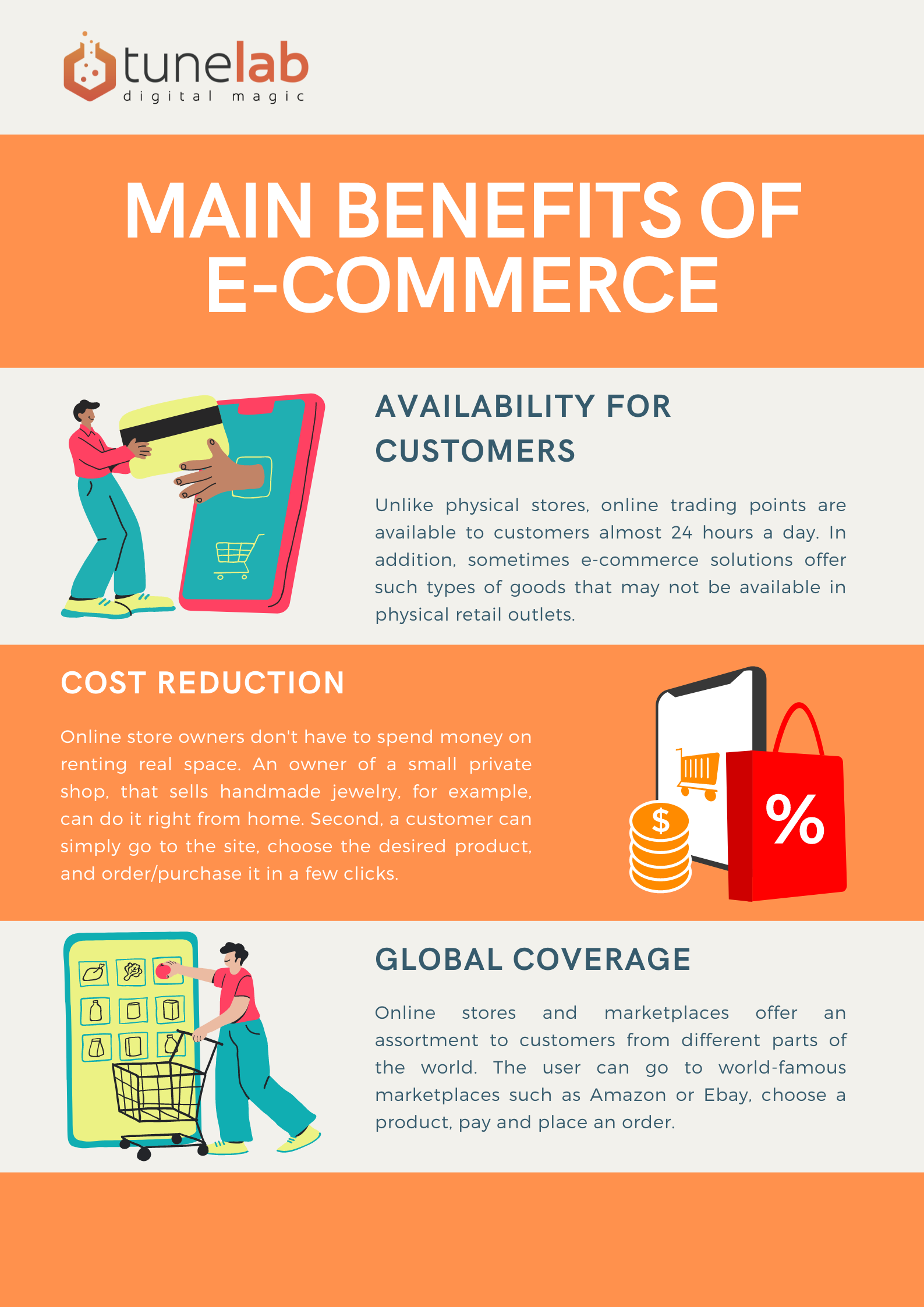E-commerce is a web development direction that enables all trade communications, financial transactions, and trade agreements over the Internet. E-commerce usually includes online stores, marketplaces, and other solutions where trading operations are possible. Using an e-commerce solution, a user can purchase any service (hotel room reservation, concert tickets) or physical/digital product (books, cosmetics, digital music track, or movie) through a PC, laptop, tablet, smartphone, or any other digital device.
Given that many cash settlements are gradually moving online, the percentage of online shopping constantly grows every year. In 2024, the percentage of online purchases is currently more than 20%, and in three years the number of online purchases and sales will increase to 27%. This trend is explained by the fact e-commerce platforms allow you to quickly and conveniently place an order and receive it without leaving your home. Therefore, developers need to know exactly how to create an e-commerce solution that will meet all the needs of customers and owners. In our new blog post, we will provide more details about the nuances of developing these web solutions.
A Step-by-Step E-Commerce Development Guide
Effortlessly Build Your Online Store with Ready-Made E-Commerce Templates
E-commerce is one of the project types, of which there are a large number among the Internet. And, of course, for such a typical project, there is a wide range of different ready-made solutions (out of the box) that will allow you to quickly develop an online trading platform. This can include WooCommerce (a plugin for expanding the functionality of WordPress, which turns a blog into an online store), Prestashop, OpenCard, CSCart, Magenta, etc. There are also Laravel modules and libraries, with the basic functionality of the online store.
So, if we receive a request for the development of an online store, then, of course, we do not create it from scratch but use one of the solutions that help us to release projects faster. For example, for the ShopTobi project, we took the Laravel library, which is used for online store solutions, and helped us to develop projects with minimum affords, like changing such elements as the logo, colors, and font without changing the architecture of the site itself. In case of custom features needed, they could be easily added because the basis is a Laravel Framework, which is a professional custom development solution.
The Pitfalls of Customizing Templates for Online Stores
Universal e-commerce templates allow easy customization – from changing the colors and logo to adding modules and changing their structure. However, making serious changes in the front end of these solutions isn’t recommended. Because a template’s original structure has already been already adopted and responsive for different devices, browsers and operating systems. When significant changes are made for the desktop, for example, you need to further adapt these changes to other devices(mobile, tablet), extensions and test them separately on each device. This is an additional cost of the client’s time and money. Without normal testing of changes on the platform, system bugs may also appear on other devices.
Speaking about the Prestashop platform, it is installed and configured in a few clicks, and then you can use it without any programming skills. But, if you want to implement unique functions, the customization of the solution will take a lot of time, be difficult and limited. The development of a new module will also take a long time. Therefore, in the case of custom solutions like PHP Frameworks, customization is much simpler. We recommend using custom solutions based on Laravel libraries or modules.
Therefore, first of all, when we start the development of any e-commerce project, we provide our customers with several template options to choose from. We strongly recommend deciding on the template that a client likes, that suits them and not changing the structure during the development process. Of course it is possible but not suggested. If a client still wants to make changes, then it is worth choosing another template that can be more easily customized.

Migrating Your E-Commerce Solution From Prestashop or a similar solution to Laravel Framework
If a client has a ready-made online store but still wants to make a unique one, then the transition of this store, from Prestashop to Laravel, for example, will be appropriate.
We actually had such a client who had a successful online store but was well aware that making changes to a ready-made solution was a wasteful decision. In this case, we suggested redeveloping the project on Laravel while keeping the current design of the original web project and migrating the DataBase. At the beginning of the work, we redeveloped a complete copy of the current online store on Laravel and started customizing and adding new features.
After all this is ready and tested on the dev server, we competently switch the old Prestashop store to Laravel. This transition is a very important and responsible moment, especially if it’s a live online store. Usually, this process is carried out either at night or at a time when there is a minimum number of users on the site since the duration of the transition can be from 5 minutes to several hours.
No less important role is played here by adjusting the site indexation after switching to another platform because Prestashop and similar have its links structure, and Laravel has its own one. In order not to lose the position of the site among the search engines (Google, Yahoo, Bing, etc.), we need to be sure that SEO and URL redirects are configured correctly so that links remain indexed by the search bot. When we do a 301 redirect, the Google search bot, for example, goes to the old link stored in the database and gets to the redirected URL. The system forwards the bot to the current link on the same page, and then it already remembers the new link in the database. Thus, positions in the search are either not lost at all or are lost minimally.
Understanding E-Commerce Business Models
This article would not be complete if we did not mention the different types of online trading businesses, depending on the type of customers. There are different types of e-commerce business:
- B2B (Business-to-Business) is a model where both parties to a trade agreement are companies. For example, a company that manufactures dishes orders raw materials from another company, which extracts these raw materials.
- B2C (Business-to-Customer) is a model where the company sells its goods directly to the end consumer. The classic option is when an online store sells household appliances to customers who can use them for their own home needs.
- B2G (Business-to-Government) is a model where a company sells goods or services directly to governments and public authorities. An example of such cooperation can be software that an IT company develops for a government agency (for example, a program for maintaining and storing electronic documents).
- C2C (Customer-to-Customer) is a model where consumers sell goods to other consumers. A vivid example of C2C work can be various marketplaces where people sell used goods or rent out a room or apartment.

Exploring the Benefits of E-Commerce
E-commerce solutions are among the most common web solutions because there is a great demand for online shopping. They provide businesses and customers with the following benefits:
- Availability for customers. Unlike physical stores, online trading points are available to customers almost 24 hours a day. In addition, sometimes e-commerce solutions offer such types of goods that may not be available in physical retail outlets.
- Cost reduction. There are several options as to how online shopping can save costs. First, online store owners don’t have to spend money on renting real space. An owner of a small private shop that sells handmade jewelry, for example, can do it right from home. Second, a customer does not have to spend time getting to the physical store on time. He can simply go to the site, choose the desired product, and order/purchase it in a few clicks.
- Global coverage. Based on the previous point, online stores and marketplaces offer an assortment to customers from different parts of the world. The user can go to world-famous marketplaces such as Amazon or eBay, choose a product, pay, and place an order. The only thing left for the buyer is to wait one to several weeks for his goods from abroad.
Mastering E-Commerce: Our Experience in Building Marketplaces
Among the cases we have worked on is the multifunctional platform URCTRL, which combines visual content management in social networks, a database for content storage, and a separate community in the form of an Instagram-like social network. But URCTRL also includes a marketplace where users can put goods up for sale, and buyers themselves can make purchases and payments through this platform even in crypto in the near future.
In particular, the marketplace is worth mentioning. A buyer is looking at the product that is marked by the seller in the photo (up to 5 products can be marked in one photo). If a buyer is interested in the displayed product, they can add this product to their saved list and send a request to the seller. To pay for goods with real money, the Stripe payment system was implemented in URCTRL.
If a buyer is not satisfied with the price of the product, they can offer their price on the platform. After placing a bid, it is displayed on the page with the product, as well as the number of bids made by other buyers. A seller, accordingly, receives a notification about the bids made and chooses the one that suits them best.
Even though sometimes e-commerce solutions development isn’t the most difficult web development area, there is still a demand for the creation of these web solutions among commercial enterprises. To simplify and speed up e-commerce solutions development, there are several ready-made solutions and templates, such as WooCommerce, Prestashop, OpenCard, Magenta, etc. These solutions are the most suitable if a client wants a standard online store with a minimum number of changes. If a client still wants to implement unique features that the previous solutions can not cover, then the recommendation is choosing an e-commerce solution based on a brand new, customized template.
Regardless of whether you plan to launch a simple online store or a complex marketplace, investing in a quality e-commerce solution opens the door to a global market and many new customers. Because even such easy-to-develop web solutions as e-commerce greatly simplify the work of online stores in selling goods and services to their customers.



